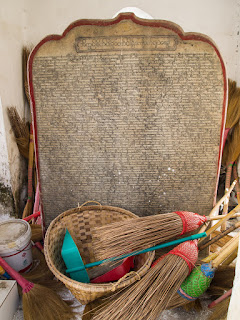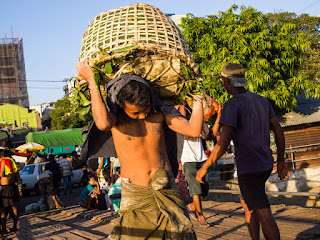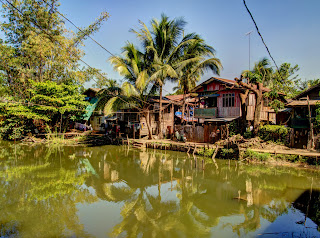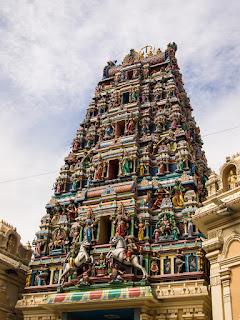It was perhaps too early in my recovery to push myself as I
did, but I sped away from Mandalay and from caution on the seat of a bicycle to
explore the regions outside of the city’s limits. The map I had scribbled down from the
internet had so vastly oversimplified the routes I needed to take it was
essentially useless. Getting to my first
destination involved two sweaty hours of hard pedaling and exchanging gestures
with strangers for directions. Garlic
ginger sunflower seats tucked between my bag and the bicycle’s wheel mounted basket
kept me nourished and stimulated as I hustled my way to the ruined kingdom of
Inwa.
After crossing one last river by ferry, I was there. It didn’t really occur to me how disparately
removed the ruins would be from one another once I got there, which meant I
wasn’t about to get any respite from my tough bicycle ride. The lush grounds were rich with old stupas, monasteries,
and fortress walls, but my exhaustion prevented me from being there completely. A constant tug of war was being waged inside
my head, with my body pleading for rest and the adventurer in me cracking a
whip trying to propel me forward and justify my presence there. “Sweet mercy, I need to sit down,” against “Let’s
do it! There’s so much to see!” Climbing the extra step for the best vantage
point, venturing a hike between inviting rice paddies, or trying an exploration
of shady banana groves were all very tempting but too great a chore to
justify. I was a diminished version of
myself. Luckily the locals in Inwa didn’t
seem to realize you’re supposed to overcharge tourists, so I kept my tank full,
gulping down sweet coconut breads, fizzy lychee soda, and these amazing puffs
made form chickpea flour at a cost next to nothing.
En route to my next destination, my path was impeded by a
parade: children of all ages were dressed in royal garb and marched in groups
or were carried by horses wreathed by colorful garlands and shaded by umbrella
carrying tenants. Oh, and all this was
set to Gangham Style – its catchy hooks having so captivated the world a day
rarely goes by without my hearing it.
The parade was capped off with an elephant dance performed by two
dancers inside a sequined elephant costume.
Set to a live band playing cutesy Asian pop with classical Burmese
beats, the elephant twirled its trunk and kicked around in carefully timed
circles to the rapture of all the village’s children.
Classical Burmese music is built on completely different foundations
than anything heard in the west, and its sound is achieved by taking a
xylophone, a couple bells, a few drums, half a dozen cats, and throwing all of
it in the spinning back compartment of a cement truck. Popular music on the radio sounds quite like
pop radio did in America, but twenty years ago.
Cover songs are quite popular and the male youth prefer the sounds of
Burmese KoRn. Particularly when they are
wearing black clothes.
Having passed it on the way to Inwa, I had little difficulty
finding my way to Amanapura, where the world’s longest teak bridge permits foot
traffic over Taungthaman Lake. Long, but
shallow, the lake invites local
fishermen to wade in waist deep, all the way to the middle of the lake where
they hunch over in tense pose waiting for the right time to jerk their poles
and seize their quarry. The bridge is
narrow enough to allow only a few pedestrians at shoulder’s width apart to
pass, and the bridge crooks in the middle like a bent elbow in a long reach to the
opposite bank. The far side is so far
away the bridge almost disappears from view.
From my vantage in the water, I watched a man who seemed to be a
duckherd, ushering about a thousand ducks safely to the other side. I watched the mating dances of dragonflies
who remain only briefly entwined in aerial love making before breaking free and
setting immediately to planting eggs on a twig unfurling from out of the water.
Foot traffic on the bridge increases just prior to sunset,
and homeward bound monks and fisherman dragging bicycles carting away the day’s
catch all become silhouetted dramatically by the reddening sun, and their forms
blend seamlessly into the silhouette of the bridge’s emaciated timbers of teak crisscrossing
beneath them . All becomes mirrored upside-down
when seen from a tiny peninsula jutting into the lake’s west bank, and the
overall effect made for a beautiful and very memorable sunset.
I elected to risk getting lost again by attempting a more
direct route back to Mandalay. I kept my
bearing by playing a game I called “follow the white people,” as all the sunset
chasing tourists were back into busses and taxis and headed the same way I
was. If unsure, all I had to do was
pause and study the passengers in passing vehicles until I felt again sure of
myself. I had a big dinner and despite
my expenditure of energy throughout the day, it seemed that during the sun’s
setting I had finally reclaimed my health, and I celebrated the fact by singing
idiotically 90s radio hits while slipping through hectic Asian traffic –
traffic that no longer intimidated me but inspirited me by its kinetic energy
and challenge. Just before I reached my hotel,
I was magnetized away from my course by the lights and music of some kind of cul-de-sac sporting event. Six men in blue and yellow jerseys were
pacing in a tight circle playing wicker football hacky sack set to live music,
narration, and cheers whenever the hollow ball was kept off the ground at a
notable length. With practiced twirls
and contortionist kicks they took turns until one man stole the show and kept
the ball suspended in the air by the exact same behind the back kick technique
over and over for a few dozen bats before passing the ball along. I would have been happy to grab a chai and join
the spectators but I had to steal a shower and wash away the day’s dirt before
catching an overnight train.
Despite Mandalay’s hideous train station, I was counting on
the night’s commute to be a welcome relief compared to my awful bus
commutes. In my reclined chair on the
train, I unfurled my shawl, leaned back deeply, and stretched out, enjoying the
leg room. I was ready for a good night’s
sleep to recharge my batteries, but shortly after we left the station, I braced
myself for a different kind of night.
All night long the train would alternate from the kind of smoothness
typical of a train to severe bouts of convulsing back and forth up and down as
if the train was skipping merrily in the air along a series of bounce houses by
the roadside. After recovering from the
first series of trainquakes all of the train commuters got up to rearrange
their luggage to make sure it wouldn’t later avalanche upon themselves as they
made optimistic efforts to get some sleep that night. Conditions later worsened when the night cold
seeped into the car, more penetrating than my shawl could inhibit. Unkempt tree branches scratched against the
sides of the train, generating stereophonic metallic screeches. When I reached Bagan at five thirty in the
morning and latched on to the back of a pickup truck – too full to accommodate another
sitter – my teeth chattered away and my legs shook violently beneath me with a
restless night’s accumulated chill. I
wrapped my elbow tightly as I could around the roof rack and hoped finding a
room in Bagan wasn’t so difficult that I’d once again consider homelessness as
a realistic option.

















































